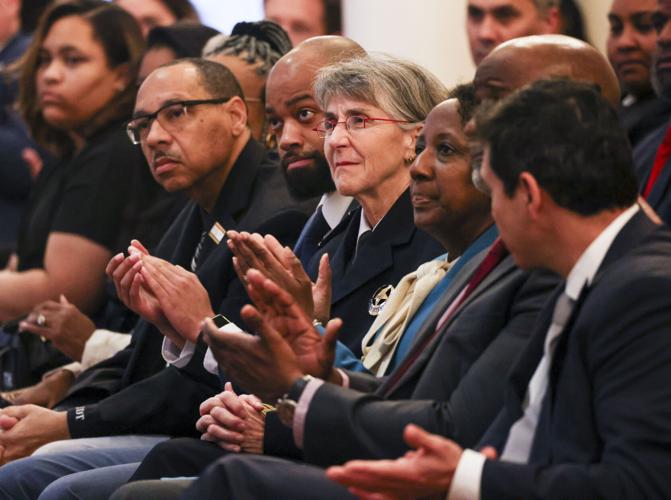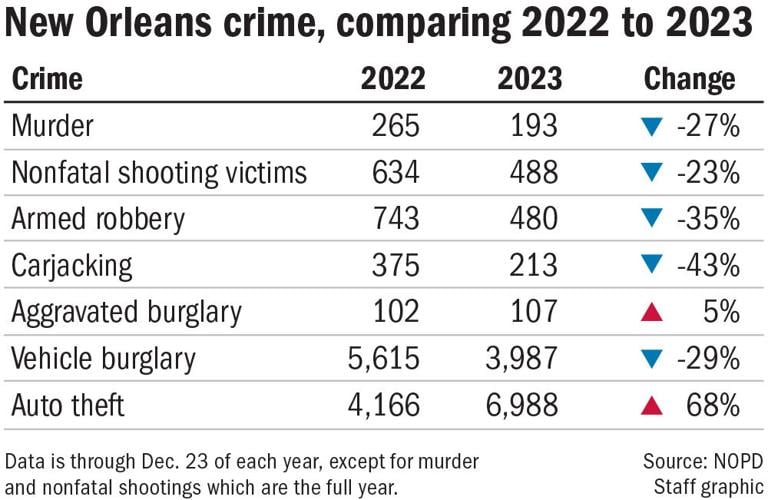A city's murder rate is perhaps the starkest measure of its level of interpersonal violence — but it’s not the only one, and last year in New Orleans, homicides weren't the only type of violent crime that ebbed dramatically.
While killings dropped 27%, other categories of violent crime that made 2022 one of the bloodiest years in memory saw similar decreases. Carjackings dropped 43%, armed robberies were down 35% and nonfatal shootings were down 23%, according to data from the New Orleans Police Department's Analytics Unit.
The trends largely mirror those seen nationwide. Cities across the country were expected to see a decline in killings in 2023 of about 10% to 12%, according to researcher Daniel Webster, a Johns Hopkins University professor who studies gun violence. New Orleans is outpacing that rate, with a more than 27% drop in homicides compared to last year.
City Council member and Criminal Justice Committee chair Oliver Thomas credits police deployment plans crafted by interim NOPD Superintendent Michelle Woodfork in February and bolstered by her successor, Superintendent Anne Kirkpatrick, via federal and local partnerships.
“When you target the most violent offenders in any category, it impacts crime in a positive way,” Thomas said. “We don’t have people who shoot one or two people — they have a history of violent assaults, carjackings… They slip through the cracks and wind up on the street.”
A department that has roughly 900 commissioned officers — the lowest staffing level in a generation — is responsible for the drop in violent crime, according to Mayor LaToya Cantrell. Though manpower is well below Kirkpatrick’s stated minimum goal of 1,100 officers, the NOPD was able to maximize its limited resources by focusing on repeat violent offenders, Thomas said.
It’s a strategy reminiscent of one adopted in the 1990s by then-Superintendent Richard Pennington. By rounding up many of New Orleans’ 200 most wanted criminals back then, the NOPD helped drive one of the largest violent crime drops in city history, when the city went from a record 424 murders in 1994 to 159 in 1999.
Digging into the data
Sometimes the difference between a homicide and a shooting comes down to poor aim, luck or good emergency medicine. But 2023's numbers showed an overall drop in gun violence, not just gun fatalities: Last year, 488 people were wounded in shootings, compared to 634 in 2022, according to a Times-Picayune analysis.
Meanwhile, mass shootings dropped by half — from 12 in 2022 to six in 2023. There were 55 mass shooting victims in 2022 and 27 in 2023. Of those victims, nine died from their wounds in 2022, and seven died from their wounds in 2023.
Carjackings, which surged in otherwise sedate areas in 2022 and helped create a climate of fear, also plummeted from 375 in 2022 to 213 in 2023. But in what crime analyst Jeff Asher on his Substack calls a “fascinating and rare” phenomenon, their nonviolent analogue — auto thefts — surged even as carjackings fell, from 4,166 in 2022 to 6,988 in 2023.
Asher credits the social media-driven Kia and Hyundai challenges, which made hot-wiring those vehicles almost as easy as opening a Coke bottle, for the inversely proportional trends.
Thomas said economic factors compelled some car thieves.
“Some kids were joyriding, but a lot were part of a carjacking ring,” he said. “Some of that stuff has been interrupted by the work being done in identifying who is hiring these kids. At one time, it was $350 to $450 to get a car and bring it to the chop shop.”
An evolving strategy
Installed in September, Kirkpatrick is the first outsider to lead the department since Pennington, and the NOLA Coalition counts her hiring and 50% pay bump among its wins. The group of 570 nonprofit and business organization banded together in the depths of the violent crime crisis mid-2022 to create a crime plan of its own, a move founder Michael Hecht called “narratively and politically powerful.”
In its end-of-year statement, members applauded the NOPD’s efforts while reiterating their own $7.5 million investment in youth services including childhood literacy, mental health and recreation, among other things — dollars members have raised so far as part of a three-year, $15 million goal.
“Raising millions for youth services…not only helps provide services, but makes clear that we need ‘safety today, along with investment in tomorrow,’” said Michael Hecht, a member of the NOLA Coalition.
Thomas agrees that continued investment is critical when it comes to preventing future violent crime surges.
“Fund those programs impacting kids in positive ways,” he said. “If we do that, it is going to be part of a sustainable effort: keep us off that roller coaster of the leading nation in crime, going down, leading the nation in crime again.”
Jeff Adelson and The Associated Press contributed to this report.


